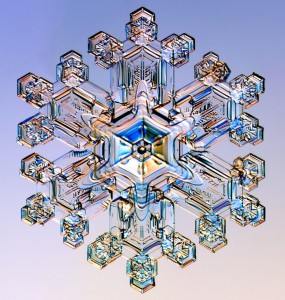 In the Flathead Valley we are lucky to be able to experience “winter water” in the form of snow. Evaporation from the ocean, lakes, streams, plants, and even our breath puts water vapor into the air. When the air is cold enough snow flakes grow from that water vapor, literally out of “thin air. Snow flakes form as crystals, just like diamonds and other gems and minerals. Flakes can look like prisms, plates, dendrites, columns, rosettes, stars, triangles; so many kinds that scientists don’t agree on how to classify them. Perhaps you have noticed them on your sleeve, or on the car. As soon as you pick one up to get a closer look, it’s gone! Temperature and wind contribute to the endless variety in the shapes of the crystals, but they all have a general six-sided shape.
In the Flathead Valley we are lucky to be able to experience “winter water” in the form of snow. Evaporation from the ocean, lakes, streams, plants, and even our breath puts water vapor into the air. When the air is cold enough snow flakes grow from that water vapor, literally out of “thin air. Snow flakes form as crystals, just like diamonds and other gems and minerals. Flakes can look like prisms, plates, dendrites, columns, rosettes, stars, triangles; so many kinds that scientists don’t agree on how to classify them. Perhaps you have noticed them on your sleeve, or on the car. As soon as you pick one up to get a closer look, it’s gone! Temperature and wind contribute to the endless variety in the shapes of the crystals, but they all have a general six-sided shape.
Snow can fall as individual flakes, flakes hooked together, or large “puff ball” clumps of crystals. Artificial snow is made by freezing water drops, so doesn’t have a crystal shape. Snow is less dense than its liquid counterpart (rain) but varies in its water content. Dry snow can take up to 100 inches to melt down to one inch of rain. When you walk on dry snow you can hear the crunch of ice crystals rubbing against one another under your feet. When you ski through it, it blows up as light and fluffy powder and you feel like you are floating.
Fresh, fluffy snow readily absorbs sound waves. It is very quiet during and just after a snowstorm. Sometimes it makes you want to whisper! As the snow surface hardens, sound bounces off and travels clear and far. All that frozen water provides a blanket of insulation for the ground. The air above can get very cold but the snow keeps the ground close to freezing. This protects plant roots and many small animals. Up north, the Eskimos make igloos out of it to stay warm! Snow accumulates all winter, storing water which will melt in spring and summer. The mountain snowpack contributes up to 75% of surface water supplies for our lakes and streams, keeping them flowing year-round.
While it is accumulating, we can enjoy it by activities such as snowshoeing, sledding or flake watching. A simple magnifier will help you see the crystals better. Children love to make “snow angels? by lying down and moving their arms to create wings. We can discover who else has been here by looking at the footprints or tracks they leave in the snow. Dog, bird, deer, people!
Indoors, you can make cutout snowflakes like the ones you see outside. You can try to create “fossil? snowflakes with superglue, or create ice spikes in the freezer using distilled water. Check out how at Snow Crystals.

![Margaret Barr's "Strange Children" [ballet], 1955 / photographer unknown](https://flatheadcore.org/wp-content/uploads/2024/03/4944459226_e4c3f8fe5b_o-360x240.jpg)
